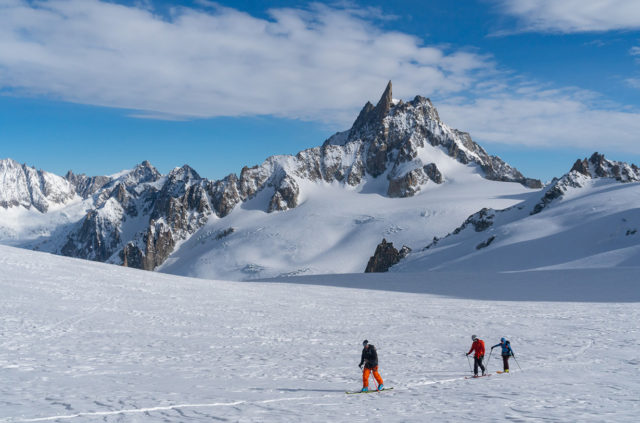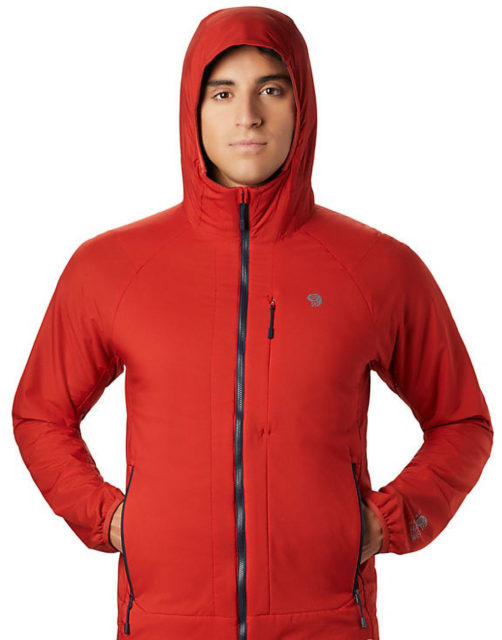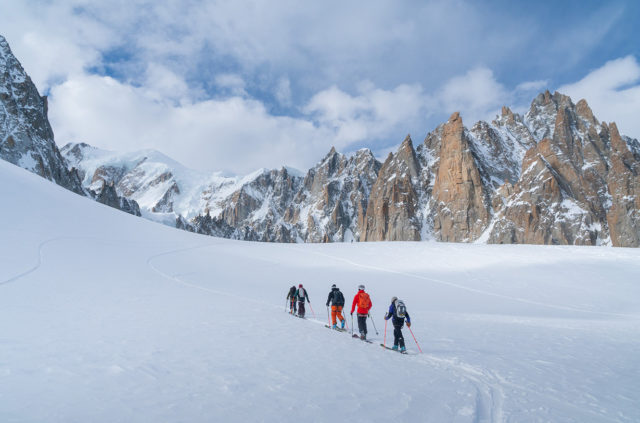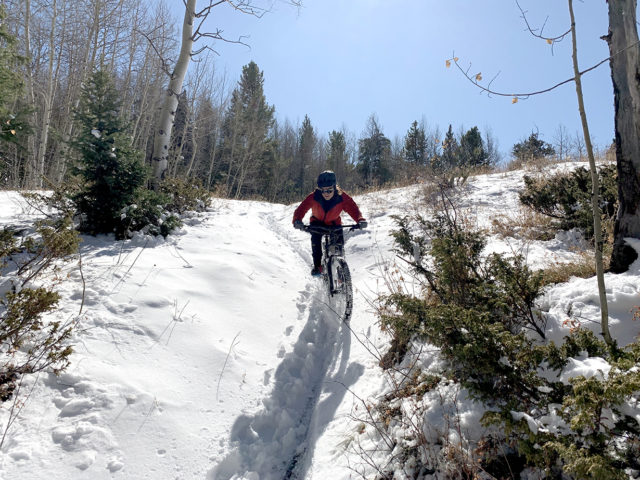Mountain Hardwear Kor Cirrus Hybrid Hoody
Test Locations: Crested Butte, Front Range, Rocky Mountain National Park, Colorado; Wasatch Range, UT; Courmayeur, IT; Valais, CH
Days Tested: ~25
Reviewers:
- Sam Shaheen: 5’10”, 145 Ibs
- Luke Koppa: 5’8”, 155 lbs
Size Tested: Medium
Blister’s Measured Weight (size Medium): 307 grams
Materials:
- Face Fabric: Pertex® Quantum Air™ 20-Denier Stretch Ripstop
- Body & Hood Insulation: Primaloft® Gold Active
- Sleeve Insulation: Grid Fleece
Stated Features:
- Highly breathable stretch insulation mapped for core warmth
- Articulated fit with seamless underarm gusset
Pockets:
- 2 exterior hand pockets (zippered)
- 1 exterior chest pocket (zippered)
MSRP: $200

Intro
The “active” insulation market has been rapidly expanding over the past few years. It seems like pretty much every company on the market has its own version of an insulator that’s meant to be much more breathable than traditional down and synthetic-insulation pieces. Most active-insulation pieces have been very similar in the past few years, but now we’re seeing companies experiment more with the different fabrics, insulations, and constructions, and in turn, we’re seeing this category get a bit more diverse and specialized.
The Kor Cirrus Hybrid Hoody is a good example of this. Unlike most jackets with the “hybrid” moniker, the Kor Cirrus Hybrid Hoody doesn’t have softshell or fleece panels added in — the hybrid name denotes mapped insulation throughout the jacket with much lighter insulation on the arms and the sides of the torso and heavier insulation elsewhere. The idea is that you get more warmth where you need it, and much less warmth where you don’t.

The Kor Cirrus Hybrid is an active insulator designed especially for high-output activities, but so are most active insulation pieces. So, how does the Kor Cirrus Hybrid compare?
Fit
Sam Shaheen: The size Medium Kor Cirrus Hybrid fits my 5’10”, 145 lbs frame just about perfectly. I have just enough room in the torso to fit a thick base layer and perhaps one other form-fitting layer (like the Patagonia R1 Techface Pullover). But for the most part, I just wear this piece over a base layer.
The sleeves hit my hand right at the first knuckle (though the cuffs hold them comfortably at my wrist) and the hem hits me just about mid-butt. (By the way, “mid-butt” might be my new favorite hyphenated word.)
This piece has the exact fit that I would expect from a high-output midlayer — slim with room to move. Great job, Mountain Hardwear.
Luke Koppa: I’m 5’8”, ~155 lbs and the size Medium Kor Cirrus Hybrid Hoody also fits me pretty perfectly. It’s a slimmer fit than most traditional puffies like the Patagonia Down Sweater, Patagonia Micro Puff Hoody, and Stio Pinion Down Pullover, but very much in line with other active insulators like the Patagonia Nano-Air Jacket and Strafe Alpha Direct Insulator. I’ve never felt restricted by the Kor Cirrus Hybrid Hoody, but it’s also never felt very bulky (which is aided by the fairly thin and mapped insulation).
Features
Sam: The Kor Cirrus Hybrid Hoody is mercifully light on features. There are three exterior zippered pockets — one chest pocket and two hand pockets. There is a shock cord adjustment system for the hem. The cuffs use a simple elastic binding at the edge to seal in heat. The hood is not adjustable and is sized for under-the-helmet use. The hood isn’t skull-cap tight like on a piece like the Patagonia R1 — there’s room for a thick hat underneath but not much else.

Luke: Yep, not a ton to talk about here. I very much appreciate Mountain Hardwear including an insulated chest pocket on Kor Cirrus Hybrid Hoody since I almost always put my phone in my midlayers’ chest pockets (to keep it warm and easy to access). The hand pockets on this piece do get covered up by some pack waistbelts, but I barely ever use handwarmer pockets when wearing a pack anyway, so not a huge deal for me. The hood doesn’t sit quite as comfortably under a helmet than slimmer hoods like that on the Patagonia R1 Hoody, but since the insulation and fabric are quite thin on the Kor Cirrus Hybrid Hoody, it still feels pretty comfortable to me when worn under a hat or helmet. And while I still think most of Patagonia’s midlayers have my favorite cuffs, due to how comfortable they are when scrunched up on my arms and how flat they lay when fully extended, I never found myself being annoyed by the simple elastic cuffs on the Kor Cirrus Hybrid Hoody.
It’s also worth noting that Mountain Hardwear makes a non-hooded version of this piece for those who would rather save a bit of weight and bulk by ditching the hood. The Kor Cirrus Hybrid Jacket still has two hand pockets, one chest pocket, and a full-length front zipper.
Weight
Sam: At 307 grams in a size Medium, the Kor Cirrus Hybrid Hoody is quite light. There are a handful of jackets that come in lighter, but almost all of them have fewer features (the Patagonia Nano-Air Light Hoody lacks a full-length front zipper and handwarmer pockets and the Strafe Alpha Direct Insulator doesn’t have a hood) or don’t have a protective outer shell (like the Rab Alpha Flash and Norrona Lofoten Alpha Raw).
The only comparable jacket we’ve reviewed that’s lighter is the Arc’teryx Atom SL Hoody. And even then, it’s only by about 30 grams. Bottom line? The Kor Cirrus Hybrid is very light.
For reference, here are some of our measured weights for several active-insulation pieces we’ve used in this category. Keep in mind the size differences to try to keep things apples to apples.
251 g Rab Alpha Flash Jacket, size Medium
272 g Arc’teryx Atom SL Hoody, size Large
272 g Strafe Alpha Direct Insulator, size Medium
274 g Norrona Lofoten Alpha Raw Zip Hoodie, size Medium
299 g Patagonia Nano-Air Light Hoody, size Medium
307 g Mountain Hardwear Kor Cirrus Hybrid Hoody, size Medium
364 g Patagonia R1 Hoody (stated weight)
365 g Outdoor Research Ascendant Hoody, size Medium
410 g Patagonia Nano-Air Hoody, size Large
415 g The North Face Summit L2 FuseForm Fleece ½ Zip Hoodie, size Medium
416 g Patagonia R1 TechFace Hoody, size Medium
425 g Outdoor Research Refuge Air, size Medium
427 g The North Face Ventrix Hoodie, size Medium
437 g Patagonia R2 TechFace Jacket, size Medium
483 g Black Diamond First Light Hoody, size Medium
Materials
Sam: The face fabric on the Kor Cirrus Hybrid is 20-denier, stretch-ripstop Pertex Quantum Air. Unlike most Pertex fabrics, the Quantum Air fabric on the Kor Cirrus Hybrid Hoody is very supple, not super crinkly, has a bit of stretch, and is air permeable. The insulation in the sleeves is a hanging grid fleece that is extremely light, while the insulation on the body and hood is Primaloft Gold Active.
Luke: In addition to what Sam efficiently summed up, I’d add that, as an entire piece, the Kor Cirrus Hybrid Hoody is very comfortable. It doesn’t have a crinkly, sticky, shiny fabric like those on most non “active” insulation pieces, and in addition to their improved breathability, that’s one of the other things I love about most active insulation pieces. They’re just very comfortable.
It’s also worth noting that the PrimaLoft Gold Active insulation used on this piece is not very heavy or thick — comparing it to other active insulations, the insulation in the Kor Cirrus Hybrid Hoody feels notably thinner and lighter than the 60-g FullRange insulation in the Patagonia Nano-Air Jacket and the 80-g Ventrix insulation used in The North Face Ventrix Hoodie. While we don’t have the stated weight of the Primaloft Gold Active insulation in the Kor Cirrus Hybrid Hoody, I’d guess it’d come in somewhere around or under 40 grams per square meter.
Weather Resistance
Sam: The Pertex shell on the Kor Cirrus Hybrid does a good job of blocking mild weather. In strong winds, I definitely feel some air getting through and in heavy and / or wet snow, I have experienced water getting through the shell.

I would rank the weather resistance of this piece right in line with other active insulation pieces on the market like the Patagonia Nano-Air or The North Face Ventrix. It probably doesn’t block quite as much wind just because it is a bit thinner, but the upside to that is that it is much more breathable than those jackets.
Luke: Yeah, the Kor Cirrus Hybrid Hoody seems about average, or a little below average for an active insulation piece when it comes to weather resistance. By that, I mean it’s not fully windproof and it’s a bit less water-resistant than traditional insulators with tighter-weave, less-breathable fabrics.
I wore the Kor Cirrus Hybrid Hoody during a surprisingly snowy mountain bike ride last November, and I could very distinctly feel the wind cutting through the areas around the sleeves with the lighter, grid-fleece insulation. Those sleeve panels still provided more warmth and wind resistance than just a baselayer and the PrimaLoft-insulated portions of the jacket do a pretty good job of blocking wind, but this is not a windproof jacket. So if you need your insulator to also function as a full wind shell, I’d look to more traditional, less breathable options. But as Sam noted, the Kor Cirrus Hybrid Hoody’s drop in weather resistance also creates a big upside.
Breathability
Sam: I love this jacket. There, I said it.
And the main reason I love this jacket is the balance it strikes between breathability and warmth. On most of my winter ski tours in Colorado, this jacket blocks just enough weather to stay dry, offers just enough insulation to stay warm, and breathes just well enough to not overheat. I’ve found it to be the ultimate always-on layer for my winter ski touring.

If you’ve read my reviews of the Patagonia R1 TechFace pieces, then you’re probably getting some deja vu right now. Yes, I love both jackets for (almost) the same reasons. But they do serve different purposes. In general, I would say that the R1 TechFace Hoody and Pullover are both a bit more breathable than the Kor Cirrus, while not being quite as warm. Below I’ll talk more about when and why I pick one over the other.
Luke: This jacket is quite breathable. Of the active insulation pieces I’ve used that feature a separate, outer shell fabric (i.e, excluding single-layer fleeces), it’s probably the most breathable, and probably also the least warm. But for ski touring, biking in cold weather, or any other winter and shoulder-season activity where I will be working up a sweat, I’ve really liked the Kor Cirrus Hybrid Hoody.
Warmth
Sam: I have almost always found active insulation pieces to be too warm for me when it comes to high-output activities. Which is very frustrating. What’s the point of breathable insulation if you overheat in it constantly? This is the exact reason I love the Kor Cirrus Hybrid. It is not too warm, at least for me. It is the least warm active insulation piece I’ve ever worn, which is what allows me to leave it on all day long on high-output ski tours.

This has become my go-to layer for mid-winter and cold-day ski touring. I can put it on at the car and leave it on all day (unless we start to go very fast or the temps rise well above freezing — then I’ll usually end up in just a baselayer). If it is going to be a bit warmer, then I go with the R1 TechFace which breathes a bit better and has less insulating value.
In summary, Mountain Hardwear has just about everything on this jacket dialed to my personal specifications.
Luke: I agree with everything Sam said, though everyone’s priorities and preferences are different, so it’s important to add some context. Like Sam, I usually overheat on the skin track in almost any insulating layer apart from very open-knit fleeces like the Norrona Lofoten Alpha Raw Zip Hoodie. And like Sam, I’ve found I can keep the Kor Cirrus Hybrid Hoody on for much longer than I can most insulated midlayers.
That said, keep in mind how you want to use this layer. If you’re looking for something that’ll keep you very warm when you’re standing still, riding chairlifts, or just casually walking around town, you’d be much better off in something warmer and less breathable like the Patagonia Nano-Air, North Face Ventrix, or a more traditional puffy.
From my experience, the Kor Cirrus Hybrid Hoody is not quite as warm as the Strafe Alpha Direct Insulator, and a bit less weather resistant. Layered under a shell, the two feel pretty similar when it comes to warmth, but the Alpha Direct Insulator blocks more wind and feels warmer when worn as an outer layer. But then the Kor Cirrus Hybrid Hoody is more breathable and I can wear it longer in warmer temperatures than the Alpha Direct Insulator.
The Kor Cirrus Hybrid Hoody is notably less warm than some of the active insulation staples like the Patagonia Nano-Air and North Face Ventrix, but again, the Kor is way more breathable. And when compared to more traditional puffies like the Patagonia Micro Puff or basically any lightweight, 800-fill-power down midlayer, the Kor Cirrus Hybrid Hoody will not keep you nearly as warm.
So, while it’s not super warm, I agree with Sam in that the Kor Cirrus Hybrid Hoody is one of the better insulators I’ve used when it comes to true, high-output, all-day activities.
Durability
Sam: After about 25 days of touring in this jacket, I haven’t had any notable issues with durability. I have found that the fabric tends to stain / get dirty easier than some other fabrics out there, but this is a pretty minor complaint.
Luke: Sam got the jacket after I had already used it, which meant I had already tumbled a couple of times in it while biking and done a good bit of bushwhacking on the way to some fishing holes. This is not a jacket that’s designed to hold up to a ton of abrasion (its fabric is very thin and light), but I don’t see it being any worse than similarly light insulators.
As always, we’ll update this review if we run into any durability issues down the line.
Who’s It For?
Sam: If other active insulation pieces have been too warm or not breathable enough for your activities, then the Kor Cirrus Hybrid is worth a strong look. So far I’ve only used it for ski touring and mountaineering, but I’m sure it will make for a good layer climbing and hiking on brisk days in the summer as well.

Luke: Yep, the Kor Cirrus Hybrid Hoody makes the most sense for people who want a midlayer that can actually stay on during high-output activities. While super open-knit fleeces like Polartec Alpha Direct are even more breathable, they’re also much less weather resistant, which is why I think the Kor Cirrus Hybrid Hoody is such a good option for things like ski touring and alpine climbing where you’re working hard but also quite exposed to the elements. It’s far from the warmest midlayer and those who don’t plan on working up a sweat will be better served by warmer, less breathable options. But the Kor Cirrus Hybrid Hoody is excellent for when you need one midlayer that can stay on pretty much all day in most winter (i.e., freezing or colder) temperatures.
Bottom Line
The Mountain Hardwear Kor Cirrus Hybrid Hoody is a natural evolution in active insulation. While there are warmer options, the Kor Cirrus Hybrid Hoody fills a void on the more breathable / less warm end of the spectrum. Using mapped insulation to fine-tune the balance of warmth and breathability, this piece is a great example of an “always-on” layer. We’ve been very impressed by the Kor Cirrus Hybrid Hoody as a cold-weather ski-touring layer, and have also enjoyed it for things like alpine climbing and cold-weather mountain biking. If you tend to overheat in most midlayers and / or are looking for a midlayer for high-output activities, give the Kor Cirrus Hybrid Hoody a good, long look.



I just discovered the Kor Preshell jackets. Same greatquantum air fabric, athletic fit and avaible in pullover and jackets. Same concept as the Pata Airshed. Moderate wind resistance, no insulation. Great for active use in moderate temps, where you might need some wind resistance at times, but breathability all the time.
Best of all, they are on sale for ~$60 at the moment.
The Kor Preshell is an excellent emergency windshell, I’ve been really digging our test sample. Softer and quieter than a Patagonia Houdini and almost as protecive.
Can you compare it to the Nano-Air-Light-Hybrid? That seems the most comparable garment, light active insulation and body mapped zones.
I love it, but, it still is quite warm and not very wind resistant.
So, it’s great on calm days(winter biking or XC skiing in the woods here in Northern MN), but on windy days, or fast downhills, it is to cold in the wind, and to hot in the sheltered areas.
So, another pitch for a Patagonia Peak Mission jacket review: slightly more wind resistant, but extremely minimal insulation, and only in the front. I just got one, but I think it will be the closest to an ‘alway on layer’ yet: breathable enough to not sweat out, You can open the front, which is the warmest, to cool down, but wind resistant and warm enough to not freeze during windy sections.
I guess I second the request for a Patagonia peak mission jacket review. Particularly how it stacks up to the R1 techface, as they appear to be similar in concept.
In my experience, the Peak Mission is much less warm but more breathable than the R1 TechFace. For me, the Peak Mission is ideal for spring touring or other warmer-weather and shoulder-season activities, while I’d opt for the R1 TechFace for cooler winter days (below freezing) where I’ll still be working up a sweat.
How does this jacket compare to the Arcteryx Atom LT? Looking at options for mountain biking in cold days.
The Atom LT is significantly warmer, and significantly less breathable. If you’ve used the Atom LT and found it to be too insulated for what you need, the Kor Cirrus Hybrid is a very good alternative. And in terms of fit and weather resistance, the two feel very similar (the Atom LT might be a bit less water resistant). I think the Atom LT is a better option for very cold weather (whether under a shell or as an outer layer), while the Kor Cirrus Hybrid is better for really high-output activities and warmer weather.
I have the Strafe Alpha Direct, Atom SL, Marmot Alpha 60, and Macpac Nitro Alpha Hoody. I typically pair the Nitro with my Kor Preshell Hoody or BD Alpine Start as outer. Just wondering if you think the Cirrus Hybrid is specialized enough that it fits a niche/use case not covered by these?
Of that group, I’d guess the Marmot is the closest piece to the Cirrus. It’s also faced with Pertex Quantum Air and uses 60g alpha direct insulation vs. the PrimaLoft Gold Active used in the Cirrus. Seems like the primary difference might be the mapping/zoning of the insulation in the Cirrus? The Marmot arms are actually lined to about a quarter way up with DriClime mesh bi-component wicking material. Marmot is a bit lighter (276.1g) than Cirrus, has 1 chest and 2 handwarmer pockets. Elasticized hem, cuffs, hood.
Hi,
how does it compare to the Outdoor Research Refuge Air Jacket (tested in 2019, with practically the same conclusion ?)
Best regards,
Late to the party here… I’m seeing this jacket in markdown, and checking out reviews. Yours is especially thorough. Thanks! Essentially, i’m looking for a synthetic equivalent of the MH Ghost Whisperer, and this would seem to fit the bill. Anticipated use will be a (somewhat) warm, compressible camp layer for warm(er) season mountain backpacking trips where temperatures wouldn’t get too close to freezing.
Also late to the party here. I’d like to point out that much of the country lives in the southern half of the country and at lower elevations, places generally left out of consideration in reviews like these. A jacket that breathes well for ski touring may also serve folks hiking and camping at temps in the 40s and 50s. At least I hope the Cirrus will for me.
I purchased this jacket in the fall of 2021 on sale and have been using it for running in the canadian winter. I often wear it with a Marmot Neothermo grid fleece baselayer at temperatures around 5-10 Fahrenheit. Add a vest such as a Marmot DriClime or Patagonia Nano Air Hybrid (or a midlayer) and you can use it around 0 Fahrenheit or slightly below… provided that you keep running! The main drawback is that the hood has no adjustment. I am 5 feet 11 and weight 140 lbs. I purchased a small and had the sleeves and hood trimmed by a tailor to ensure a very close fit. This is a very underrated jacket IMO, very affordable on sale.